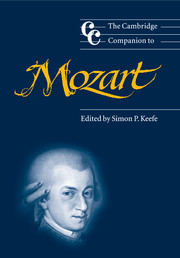Book contents
- Frontmatter
- Introduction
- Part I Mozart in context
- 1 Mozart and Salzburg
- 2 Mozart in Vienna
- 3 Mozart's compositional methods: writing for his singers
- 4 Mozart and late eighteenth-century aesthetics
- Part II The works
- Part III Reception
- Part IV Performance
- Notes
- Selected further reading
- General index
- Index of Mozart’s works
1 - Mozart and Salzburg
from Part I - Mozart in context
Published online by Cambridge University Press: 28 September 2011
- Frontmatter
- Introduction
- Part I Mozart in context
- 1 Mozart and Salzburg
- 2 Mozart in Vienna
- 3 Mozart's compositional methods: writing for his singers
- 4 Mozart and late eighteenth-century aesthetics
- Part II The works
- Part III Reception
- Part IV Performance
- Notes
- Selected further reading
- General index
- Index of Mozart’s works
Summary
In the mornings we woke to the most wonderful sounds, floating through the air like the sound of a psalterion. Three times the sweet melody ended, and three times it began again. It was the glockenspiel in the tower across from the Residenz which regularly at seven and eleven in the mornings, and at six in the evenings, played a well-chosen melody. We tried, as often as we could, to listen in the square.
For the eighteenth-century traveller, Salzburg could be a paradise. Off the beaten track and set at the foot of the Alps, it boasted natural beauties and a rich history: the city owed its post-Roman origin to the founding of the abbey of St Peter by St Rupert of Worms in 696 and of the cathedral by St Virgil in 774. In 1278 Rudolph of Habsburg made the archbishops of Salzburg imperial princes and during centuries of relative peace (except for the Peasants' War of 1525–6) the power and prestige of the court increased until it was the most important and influential archdiocese and sacred state in German-speaking Europe. By 1700, half a century before Mozart's birth, its boundaries stretched north and west into what is now Bavaria and east and south as far as Wiener Neustadt and Graz.
What the anonymous visitor to Salzburg praised so highly was the mechanical clock tower facing what is now the Mozartplatz. Constructed in the early eighteenth century, it was renovated in the 1750s to include music by the Kapellmeister Johann Ernst Eberlin and the court violinist Leopold Mozart. The works were published in 1759 by Lotter of Augsburg, together with a lengthy description of the Salzburg fortress, a short history of the city, and a charming, engraved cityscape. More than a music print, it was a souvenir for the sophisticated tourist, a memento of pleasant hours spent near the banks of the river Salzach or roaming the numerous churches, open squares and fountains that gave Salzburg its nickname, ‘the German Rome’.
- Type
- Chapter
- Information
- The Cambridge Companion to Mozart , pp. 5 - 21Publisher: Cambridge University PressPrint publication year: 2003



